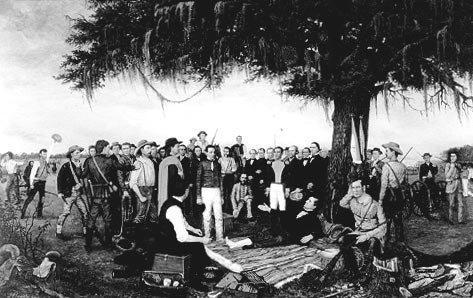|
The
Battle of San
Jacinto, the short-lived but decisive engagement that assured
Texas independence from Mexico, took place more than a decade before
the development of photography.
Because of that, subsequent generations of Texans and others interested
in history have had to rely on written accounts of the battle to develop
a mental picture of what it must have looked like that spring afternoon.
In 1886, a half-century after the April 21, 1836 battle, Virginia-born
artist William Henry Huddle greatly enhanced Texas’ collective image
of the aftermath of the fight with the large oil painting which hangs
inside the south entrance of the
Capitol in Austin.
Born in 1847 more than a decade after San
Jacinto, Huddle served for two years in the Confederate Army.
After the war, he moved to Paris
(the city in Lamar County,
not the one in France). A gunsmith by trade, he became interested
in a softer medium and left the state to study art in Nashville and
later New York. Huddle returned to Texas
in 1877, settling in Austin.
Five years later, he went to Munich for two more years of art schooling.
He returned to Austin in
1886 and shortly undertook his San
Jacinto paints.
Though cameras had yet to be invented by the time of the Texas Revolution,
Huddle did use photographic portraits of San
Jacinto veterans to add some degree of realism to the 72 by 114
inch canvas he titled “The Surrender of Santa Anna.” Unfortunately,
he did not use his brush to subtract the years from the images of
the veterans he featured, making them look older in the painting than
they would have been at the time of the battle. |
 |
| Photo
of painting courtesy of Texas State Library |
Even so, Huddle’s
painting – which the Legislature purchased for $4,000 in 1891 – is
the prime image associated with the military victory that changed
American history.
The oil, done in a formal style Huddle learned in Germany, depicts
the then 43-year-old Sam Houston lying on a colorful Mexican serape
beneath a moss-hung oak, his wounded right leg bandaged. Texas scout
Deaf
Smith is shown sitting nearby, his hand cupped around his ear.
Houston is nobly extending his right hand to the recently-captured
Mexican general.
The big transplanted Tennessean, born in Virginia, probably did extend
his right hand in Santa Anna’s direction at some point, but historians
now believe it wasn’t his right ankle that caught a Mexican bullet
that eventful day.
An exhibit at the Sam
Houston Museum in Huntsville
features a life-size diorama of the same scene, correctly portrayed
for the first time. A faux blood-stained bandage is affixed to Houston’s
left leg.
Houston descendants have long believed it was his left leg, not the
right that sustained a gunshot wound in the battle. But everyone else,
dating all the way back to Huddle in 1886 always has assumed it was
the right leg. |
James
L. Haley of Austin, author
of “Sam Houston,” the latest and arguably best biography of Texas’
George Washington, agrees with the Houston relatives on the left versus
right leg issue. But he came to that belief after the publication
of his book, which has Houston’s wound on his right leg.
“When they reprint the book, I’ll make the change,” Haley said. “I
think it was his left leg, but the only way to know for sure would
be to exhume Houston, and no one’s interested in doing that.” |
|
Other than suffering a painful wound, April 21 had been a lucky day
for Houston. His ragtag Army prevailed over a larger force of Mexican
soldiers. But that luck almost went the other way.
At one point in the battle, which was more of a rout than a true contest
of arms, Houston had charged 30 yards ahead of his men, urging them
on, when he came close to getting much more than an ankle wound.
Ben McCulloch had already fired several volleys of grapeshot from
the two cannons known as the Twin Sisters.
He was just about to touch off another round when he noticed that
Houston had ridden directly into the line of fire.
“One more second and there would have been a change in Texan command
before the battle ever started,” Haley wrote in his biography.
© Mike Cox
"Texas Tales" March
27, 2008 column |
|
|